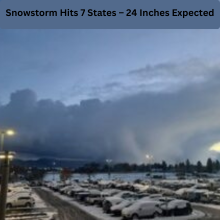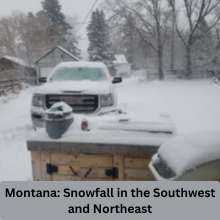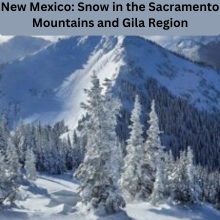
As the weather turns colder across the western United States, residents in several states are bracing for a winter storm that will bring heavy snowfall, freezing rain, and frigid temperatures. The National Weather Service (NWS) has issued winter weather warnings for seven states: Washington, Montana, Idaho, Oregon, Wyoming, Utah, and New Mexico. The storms are expected to last through the weekend, causing significant disruption to daily life and travel.
In this article, we will break down the details of the winter weather conditions affecting these states, provide important safety tips, and offer advice on how to stay safe and prepared during this winter storm.
Washington: Snowstorm and Road Hazards
Winter Storm Warnings in Washington Pass and Cascade Range
Washington State is one of the hardest-hit areas, with winter storm warnings currently in effect. The Cascade Range and Washington Pass are expected to receive up to 24 inches of snow, making travel through the region extremely hazardous. The snow is expected to accumulate rapidly, with the heaviest snowfall occurring between Friday and Saturday. This could cause dangerous road conditions, particularly in mountain passes.
Forecast: 24 Inches of Snow
In addition to the heavy snowfall, areas such as the Northwest Blue Mountains are forecasted to see between 10 and 13 inches of snow. The NWS advises that travel should be delayed unless absolutely necessary, urging drivers to take extreme caution on the roads.
Travel and Safety Recommendations
If you must travel, carrying a winter storm kit is a must. This should include tire chains, a flashlight, extra clothing, a first-aid kit, blankets, and water. You may also want to include booster cables and a shovel in case you become stranded. Given the severe conditions, avoid non-essential travel and stay updated with the latest weather alerts.
Montana: Snowfall in the Southwest and Northeast
Snow Expected in Mountainous and Border Areas
Montana, located in the northern Rockies, is bracing for its own winter weather challenges. The southwest and northeast regions of the state are expected to receive snow, particularly in areas near the Canadian border. These areas, such as Daniels, McCone, Sheridan, and Roosevelt Counties, will see light to moderate snow accumulations of 1 to 3 inches. However, higher elevations, including Beaverhead, Madison, Gallatin and Jefferson counties, could receive 1 to 4 inches of snowfall.
Potential Travel Disruptions and Warnings
Roads across Montana will likely become slick and hazardous, particularly in the mountainous areas. The NWS recommends that drivers exercise caution and be prepared for snow-covered roads. If traveling through these regions, be prepared for significant delays.
Idaho: Rocky Mountain Passes Hit Hard
Snow Forecast for Fourth of July Pass, Dobson Pass, and Lookout Pass
Idaho’s Rocky Mountain region is in for a tough weekend, with a winter storm warning in effect for several key mountain passes. Fourth of July Pass, Dobson Pass, and Lookout Pass are expected to receive up to 18 inches of snow from Saturday afternoon to Monday evening. These areas are already known for treacherous driving conditions in winter, and the heavy snow will make travel even more difficult.
Impact on Roads and Travel
Given the heavy snow forecast, drivers should expect slippery roads and low visibility, especially in higher elevations. Travelers are advised to check road conditions before heading out and be prepared for lengthy delays.
Wyoming: Snow in Mountainous Areas
Winter Weather Advisory in Teton, Sublette, and Lincoln Counties
Wyoming is also facing snow accumulation, particularly in high-altitude areas like Teton, Sublette, and Lincoln counties. Snowfall is expected to range from 4 to 6 inches over mountain passes, with up to 8 inches possible at altitudes above 10,000 feet. These snowfalls could make driving conditions hazardous, and the NWS recommends that travelers take extra precautions when driving through these areas.
Oregon: Northern Blue Mountains and Cascades
Winter Storm Warning in Place
A winter storm warning has been issued for Oregon’s northern Blue Mountains. Moderate to heavy snowfall is expected in this region, with accumulations ranging from 10 to 13 inches. A fast-moving warm front may briefly turn the snow to rain along the Washington Cascades and the Blue Mountains on Sunday, but another cold front will bring a return of significant snow.
Impact on Local Travel
The heavy snow is expected to disrupt travel in and around these mountain regions. Drivers should expect slippery roads and reduced visibility, especially along major highways. As conditions worsen, travel advisories may be updated.
Utah: Snowfall in Wasatch and Uinta Mountains
Winter Weather Advisories for Mountain Regions
Utah is also feeling the effects of the winter storms. Two areas, the Wasatch Mountains and the Western Uinta Mountains, are under winter weather advisories. Between 6 and 12 inches of snow are forecast in the Wasatch Mountains, while the Uinta Mountains may see between 4 and 8 inches.
Snow Accumulations and Caution for Drivers
Motorists are advised to slow down and use caution when traveling in these areas. Heavy snow could make roads slick and dangerous, particularly in the early morning and evening hours. Check road conditions before traveling and carry winter gear if you must be on the roads.
New Mexico: Snow in the Sacramento Mountains and Gila Region
Forecast: Up to 6 Inches of Snow
In New Mexico, winter weather warnings are in effect for the Sacramento Mountains and the Southern Gila Region Highlands. Up to 6 inches of snow is expected, particularly at higher elevations above 7,500 feet. Snow is likely to cause hazardous driving conditions, especially on bridges and overpasses, which tend to freeze first.
Road Conditions and Potential Travel Hazards
The NWS warns that roads will become slippery, and gusty winds could bring down tree branches. Drivers should plan for icy conditions, especially during the Monday morning commute.
What to Expect in the Coming Days
The winter weather warnings will remain in effect throughout the weekend, with snow continuing to fall in many of these areas. As temperatures stay low and snow accumulations build, residents should prepare for possible disruptions to daily life. Schools and businesses may close, and travel will be impacted by hazardous road conditions.
Also read: Pizza Hut’s Tomato Wine: A Game-Changer for Pizza Lovers
Preparing for Winter Weather
Travel Kits and Safety Gear for Drivers
Before heading out, ensure your vehicle is equipped with a winter storm kit. This should include essential items like tire chains, blankets, water, a flashlight, and a first-aid kit. If you’re traveling to areas where snow accumulation is expected, make sure your vehicle is equipped to handle the conditions.
How to Stay Safe in Extreme Conditions
If you’re at home, ensure your heating systems are working and you have enough supplies to last through the storm. If you become stranded while traveling, remain inside your vehicle, use blankets to stay warm, and call for help.
Winter Storm Safety Tips
Advice for Staying Warm and Safe at Home
During a winter storm, it’s important to stay indoors as much as possible. If you must go outside, layer your clothing and avoid prolonged exposure to cold temperatures. Use space heaters safely and make sure your home is stocked with food, water, and essentials.
What to Do if You’re Caught in a Storm While Traveling
If you’re caught in a snowstorm, find shelter immediately and stay in your vehicle if possible. Running your engine for brief periods can help you stay warm, but be cautious of carbon monoxide buildup.
Impact on Local Economies and Infrastructure
How Heavy Snow Affects Businesses and Infrastructure
Heavy snowfall can disrupt local businesses, especially those relying on shipments or outdoor work. Road closures and delays may also impact the transportation of goods and services. In some cases, schools and offices may close, affecting workers and students.
How to Monitor Winter Weather Alerts
Where to Find Reliable Weather Forecasts
Stay informed by regularly checking the NWS website and local news stations for updates on winter weather conditions. Alerts and warnings can change rapidly, so it’s important to stay up to date.
Emergency Services and Assistance
What to Do in Case of Emergency
If you experience a weather-related emergency, contact local emergency services. Snowplows and road crews are often deployed during winter storms, so keep an eye on updates for road closures and snow removal efforts.
Also read: Experience Bhutan’s Spiritual Secrets and Ancient Festivals
Conclusion
As winter storms continue to impact the western U.S., it’s essential to stay prepared and informed. With up to 24 inches of snow expected in some areas, residents and travelers should take extreme caution. Always carry a winter storm kit, monitor weather alerts, and plan for potential disruptions. Stay safe and take care during these challenging conditions.
FAQs
-
What should I include in my winter storm kit?
- Your kit should include items like tire chains, a flashlight, blankets, extra clothing, a first-aid kit, water, and snacks.
-
How can I stay informed about weather updates during the storm?
- Check reliable sources like the National Weather Service, local news stations, and weather apps for the latest alerts and updates.
-
Is it safe to travel during a winter storm?
- If you don’t need to travel, it’s best to stay home. If you must travel, make sure your vehicle is equipped with winter gear and drive cautiously.
-
How much snow is expected in Washington State?
- Some areas, like Washington Pass and the Cascade Range, are expected to receive up to 24 inches of snow, with other areas getting between 10 to 13 inches.
-
What should I do if I get stuck in a snowstorm while traveling?
- Stay in your vehicle, keep warm, and contact emergency services. Never leave your vehicle unless you’re certain it’s safe to do so.

